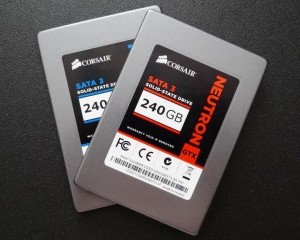 It is always an exciting time when a new controller makes it’s way on to the SSD scene. It is like seeing a new contender in any sporting event and predicting their success, or lack of, based on the balance of strength and inexperience.
It is always an exciting time when a new controller makes it’s way on to the SSD scene. It is like seeing a new contender in any sporting event and predicting their success, or lack of, based on the balance of strength and inexperience.
Our analysis today examines the new Link A Media (LAMD) 6Gbps controller found within the Corsair Neutron and Neutron GTX SSDs. Watch as the Neutron delivers a first round knockout.
It is a bit amusing when we speak to the thought of companies that ‘own the Fab’ prevailing as the victors in the SSD long race, owning the fab of course meaning that they are the manufacturers of the NAND flash memory of which an SSD is built upon. It is true that they have the ability to force SSD pricing down significantly, as we have recently seen of Micron/Crucial, and this puts third party vendors in a precarious position as they are forced to invent new ways of remaining competitive and staying at the front of the pack with the best.
Corsair was one of the first SSD manufacturers to hit the retail market and, although they have stepped a bit more carefully than many others, they have earned a reputation as providing some of the top performing SSDs money can by. Their success in SSDs has shown with their willingness to explore different controllers in search of the best, as well as bringing out non-standard SSD capacities that we still haven’t seen in many others. The Corsair Performance Pro remains to be one of the best SSDs we have tested to date and surprised everyone, as it is based on the Marvell 9174 controller and Corsair truly found the sweet spot in it’s performance.
THE CORSAIR NEUTRON FAMILY
Along with the release of the Corsair Neutron SSD, comes the introduction of a new SSD controller by Link A Media Devices (LAMD) known as the LM87800 and it is an eight channel 6Gbps controller. The Corsair Neutron family is available in two series which are the Neutron and the Neutron GTX, NAND flash memory being the main differentiator between the two. Both versions are available in capacities of 120 and 240GB and both can be found at Amazon![]() with the Neutron priced at $129 and $214 while the higher performing GTX is $149 and $251. Both SSDs have industry leading five years warranties.
with the Neutron priced at $129 and $214 while the higher performing GTX is $149 and $251. Both SSDs have industry leading five years warranties.
Performance for the 120GB Neutron is listed at 555MB/s read and 211MB/s write with 85,000 IOPS at random 4k aligned write disk access and write performance jumps to 370MB/s as capacity increases to 240GB. The GTX lists 555MB/s read and 511MB/s write transfer speeds with write performance of it’s 120GB variant being just a bit lower at 330MB/s and 80,000 IOPS. Power consumption for all is 0.6W MAX idle and 4.6W MAX active.
Exterior packaging speaks to the GTX IOPS being as high as 90,000 IOPS and both SSDs are housed within a 7mm form factor making this an ideal candidate for any ultrabooks that might accommodate this design. The below picture demonstrates the difference between the 7mm GTX form factor and that of the Corsair Force GT:
 The SSD Review The Worlds Dedicated SSD Education and Review Resource |
The SSD Review The Worlds Dedicated SSD Education and Review Resource | 

Glad to see another SSD controller apart from Marvell that doesn’t flop under incompressable data like Sandforce does.
My next SSD will likely be a 512GB. As soon as the prices come down to $400.
some crucial m4 and sandisk 512/480gb ssd already went to 389 and 359.
the prices are 399.99 and less for some good ones
Today you can get a Crucial M4 right here at the forum store for 349.00 ,512gb.
Superb review and great shoot on picture 🙂
Great review. Thanks so much! Will look to budget one of these into my next build.
Nice review indeed.
Only one thing>they are not sata 6,else perfect 🙂
all tests are to simple for me. You did not write if neutron caches data in DRAM, what happen if power ist lost. how disk will work in real world not just brand new out of the box?
look to storagereview or anandtech tests. they try to look deeper into the subject.
not all users are buing ssd to test how fast it can write one big file to laptop. many people uses SSD as smart cache for HHDs. are neutrons good for that?